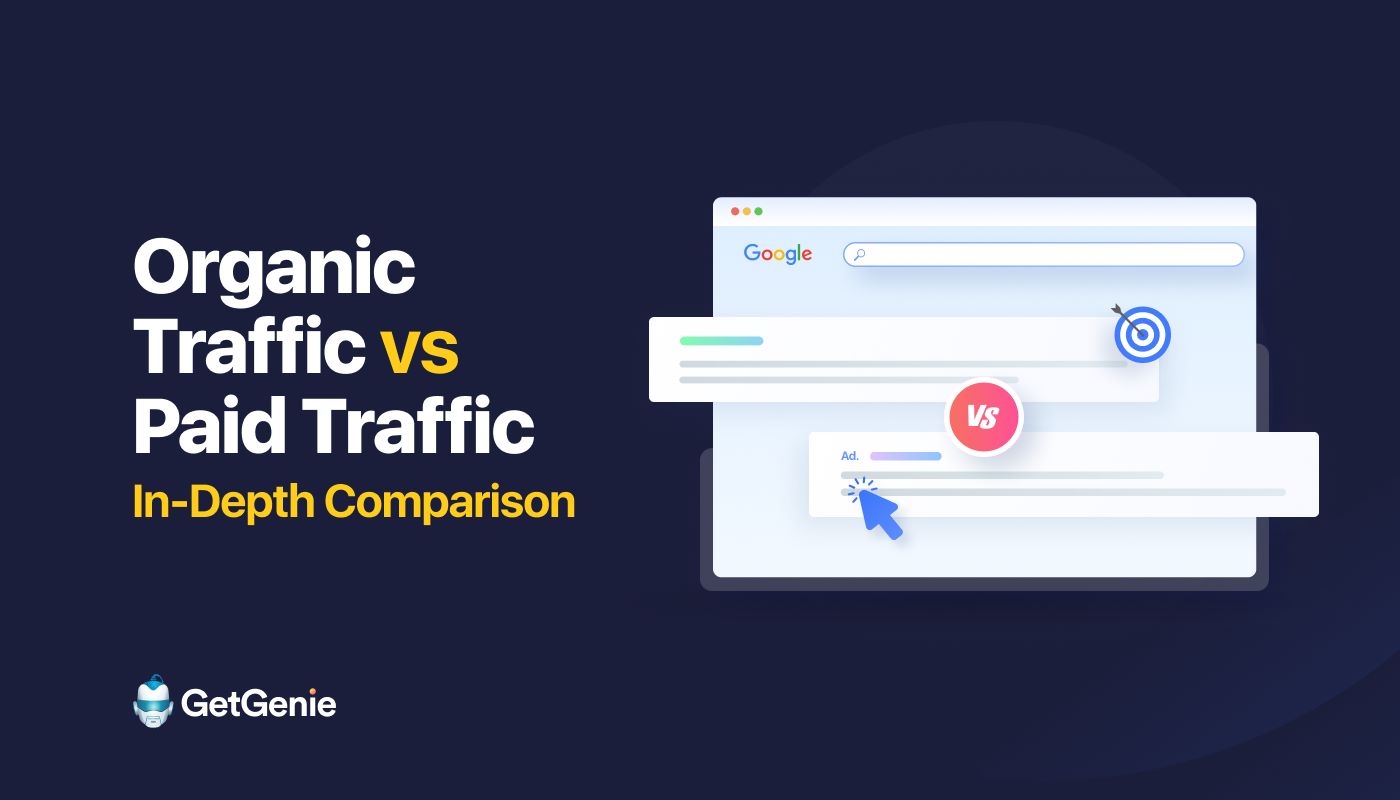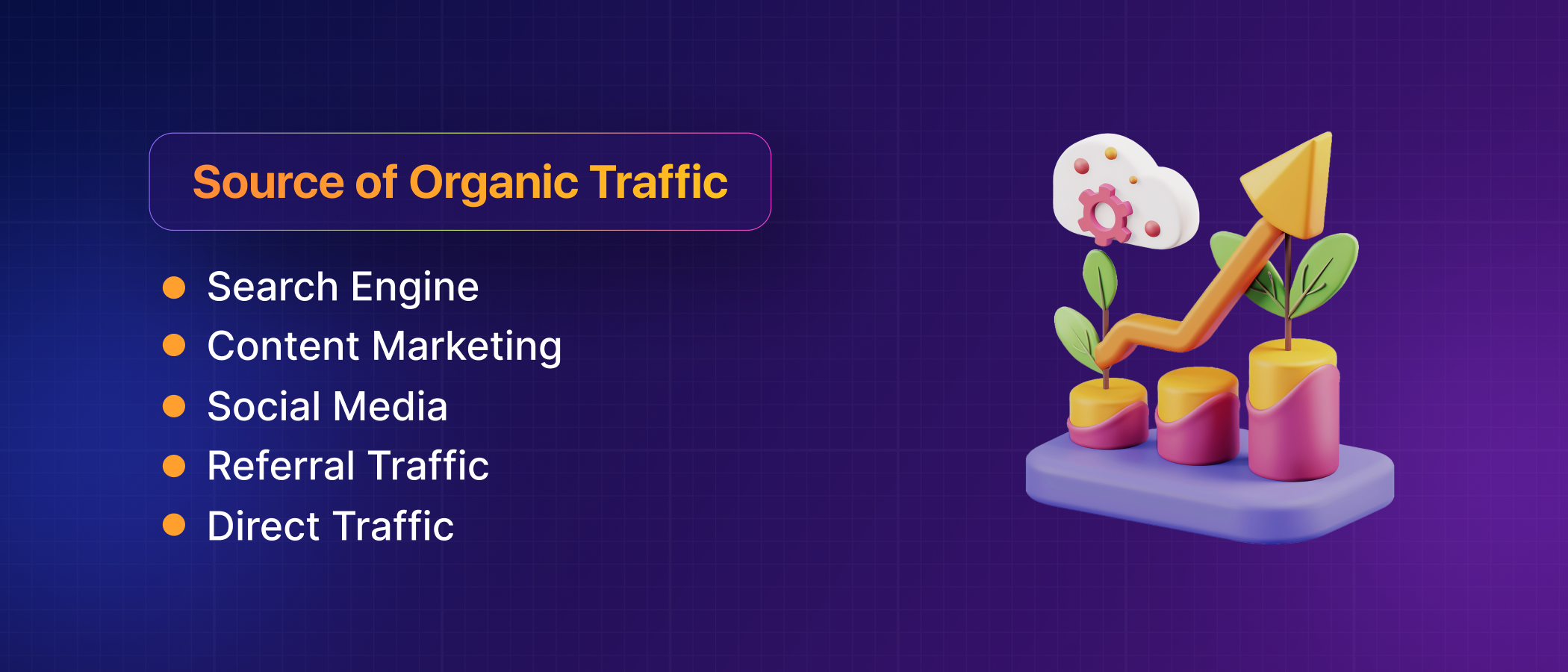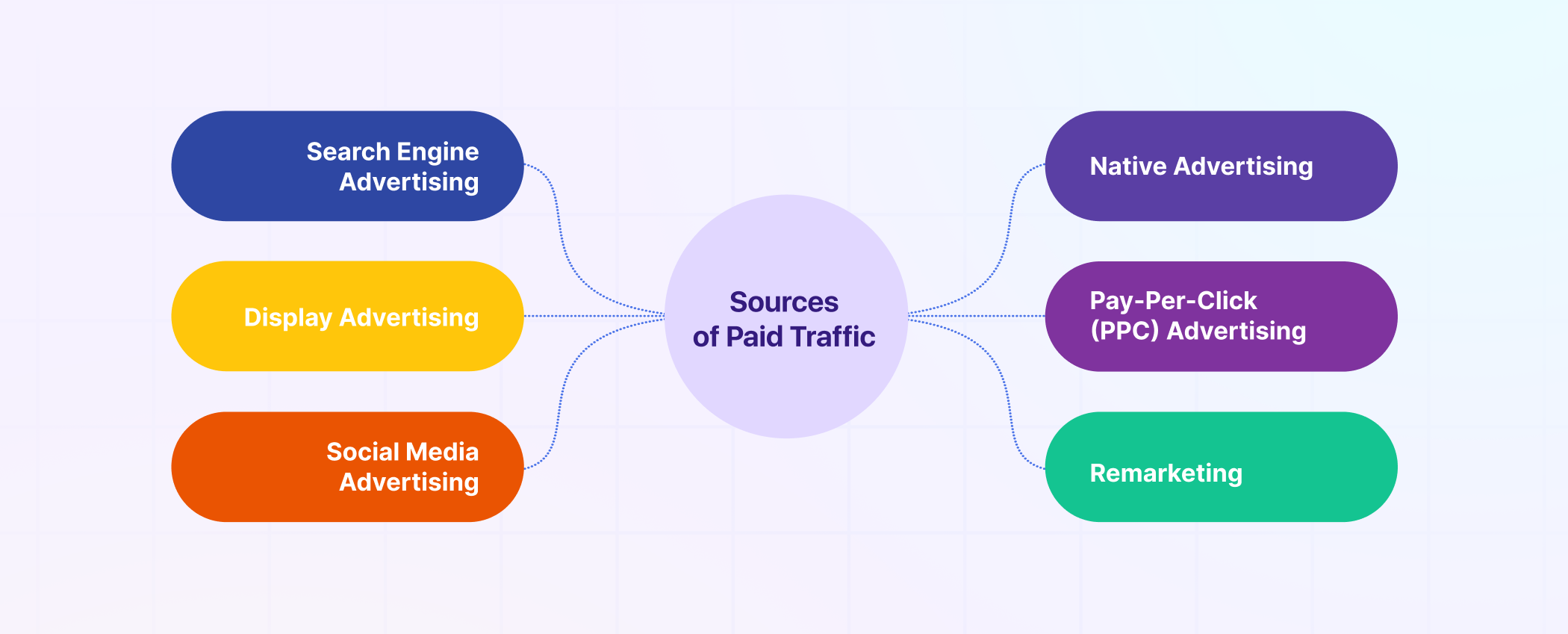Organic Traffic vs Paid Traffic: In-Depth Comparison for You!

Quick Overview
Organic and paid traffic differ in how they attract visitors and deliver results. Organic traffic comes from unpaid sources like SEO and social media, building long-term, sustainable growth. Paid traffic, such as PPC or display ads, offers quicker visibility but requires continuous investment. Each has unique pros and cons, and combining both can create a balanced, scalable strategy for steady website growth.
Driving traffic to your website is crucial for any online business. But how do you choose the right strategy?
Deciding between organic traffic and paid traffic can feel like navigating a maze. Well, fear not! This guide will determine both options and the difference between organic and paid traffic, helping you make informed decisions for your website’s growth.
What is Organic Traffic?

Imagine people finding your website through search engines like Google and referrals from other websites, not through ads. That’s organic traffic! It’s free and tends to be from people genuinely interested in your content.
Additionally, organic traffic is generated organically through various non-paid channels. It can keep growing over time if you keep improving your website.
Here are some key sources of organic traffic:
- Search Engine: Visitors find your website after searching on platforms like Google, Bing, or Yahoo.
- Content Marketing: Content marketing, like writing blogs, articles, making infographics, videos, or podcasts, can make more people see you, make you seem like an expert, and bring more visitors to your website without paying for ads.
- Social Media: When users discover your content on social media and click through to your website, it’s considered organic traffic.
- Referral Traffic: When other websites, blogs, or online publications link to your content, it improves your website’s authority and visibility in search engine rankings, leading to more organic traffic over time.
- Direct Traffic: Direct traffic refers to visitors who type your website URL directly into their browser or access your website through bookmarks.
Organic Traffic: Pros
Imagine a constant stream of website visitors – engaged, relevant, and completely free. That’s the allure of organic traffic, where potential customers arrive through unpaid search engine results. Intrigued?
Here’s a glimpse into the amazing pros of going organic:
- Organic traffic cost: It’s cost-effective since there are no direct advertising expenses involved.
- Sustainable: Once established, organic traffic can generate consistent visitors over time.
- Credibility: High search engine ranking builds trust and authority.
- Targeted traffic: Users actively searching for related topics are more likely to be engaged.
Organic Traffic: Cons
Organic traffic might sound like a dream come true – free, targeted visitors streaming to your website. But before you get swept away by the allure, be aware of the cons lurking beneath the surface:
- Slower growth: Takes time and effort to build organic ranking.
- Competitive landscape: Ranking for popular keywords can be challenging.
- SEO expertise: Requires ongoing optimization efforts.
When to Use Organic Traffic
Not every website needs a blast of paid advertising. In some cases, organic traffic can be your secret weapon, offering a sustainable and budget-friendly path to growth. But when exactly is organic the right choice for your website?
Here are some key scenarios:
- If you’re aiming for steady, consistent website traffic that grows over time
- When you are targeting specific keywords with high search volume
- Building awareness and credibility to your brand.
- If your target audience is well-defined and actively searches for specific solutions.
Remember, organic traffic isn’t a magic bullet. It requires patience, strategic planning, and ongoing effort. If you’re ready for a sustainable, cost-effective approach to website growth, consider diving into the world of organic traffic. You might just discover your golden ticket to success!
How to Grow Your Organic Traffic
Organic traffic, the lifeblood of many successful websites, requires dedication and strategic planning.
Here’s a roadmap to help you cultivate a thriving community of visitors:
1. Create Compelling Contents
But how?
- Focus on creating valuable, informative, and engaging content that resonates with your target audience and solves their problems.
- Understand the needs, interests, and search queries of your audience and tailor your content accordingly.
- Mix up content formats like articles, videos, infographics, and ebooks to cater to different preferences.
- Publish regularly to show search engines that your site is active and relevant, attracting more visitors.
2. Integrates Keywords in your Content
Remember these significant notes:
- Conduct keyword research to identify relevant keywords with significant search volume and low competition.
- Target long-tail keywords to reach specific audience segments.
- Avoid keyword stuffing and prioritize readability.
3. Build the Foundation of your Technical SEO
How to do that?
- Ensure your website loads quickly on all devices. Speed is a crucial ranking factor.
- Make sure your site looks and functions flawlessly on mobile devices, where most searches occur.
- Implement schema markup to help search engines understand your content better.
- Link relevant pages on your website to improve user experience and navigation, and distribute link authority.
4. Optimize your Off-Page to Build Authority
Here’s how:
- Earn high-quality backlinks from reputable websites to boost your website’s authority and ranking potential.
- Contribute valuable content to relevant blogs or sites to reach a wider audience and gain backlinks.
- Share your content on social media platforms and engage with your audience to drive traffic back to your website.
- Optimize your website and online listings for local searches. This is especially important if you have a brick-and-mortar presence.
What is Paid Traffic?

Paid traffic involves using advertising platforms like Google Ads, Facebook Ads, or social media sponsored posts to reach your target audience. You pay for each click that directs users to your website.
Here are the various forms of paid traffic:
- Search Engine Advertising: This involves placing ads within search engine results.
- Display Advertising: This can be in the form of banners, images, or even video ads.
- Social Media Advertising: Social media platforms like Facebook, Instagram, Twitter, and LinkedIn offer advertising options to target specific demographics based on user interests, demographics, and behavior.
- Native Advertising: Native ads are designed to blend in with the content of the platform where they appear, making them less intrusive and more engaging for users.
- Pay-Per-Click (PPC) Advertising: A form of online advertising where advertisers pay a fee each time their ad is clicked.
- Remarketing: It involves targeting users who have previously visited a website but did not take a desired action.
Where else could you use paid traffic?
Paid traffic is not only used solely in websites, but can certainly be used to drive visitors to landing pages, apps, digital businesses, and similar online assets. Here’s how it can be applied to each:
➡️ Landing pages:
Paid traffic can be directed to specific landing pages designed to convert visitors into leads or customers.
➡️ Apps:
Paid traffic can be used to acquire users for mobile apps through app install campaigns.
➡️ Digital Businesses:
Paid traffic can drive visitors to digital businesses such as online stores, SaaS (Software as a Service) platforms, subscription services, and digital content platforms. Paid traffic is an effective means for lead generation, such as offering free trials, demos, or downloadable resources in exchange for contact information.
➡️ Other Digital Assets:
Paid traffic can be directed to various digital assets, including websites, blogs, online courses, webinars, and digital products. Paid traffic increases visibility, promotes content, and generates leads or sales for these assets.
Paid Traffic: Pros
Dreaming of immediate website traffic and targeted leads? Organic growth takes time, but paid traffic offers a turbocharged shortcut.
Let’s take a look at the exciting pros:
- Fast results: See immediate traffic increase with targeted campaigns.
- Precise targeting: Reach specific demographics and interests.
- Measurable results: Track performance and optimize campaigns for better ROI.
- Scalability: Flexibility based on budget, goals, and performance metrics.
- Control and Customization: Full control over various aspects of ads, including ad copy, targeting criteria, budget allocation, and scheduling.
- Competitive Advantage: Helps outbid competitors for ad placements, target niche audiences, or launch timely promotions and offers.
- Brand awareness boost: Get your brand seen by a wider audience, building recognition and trust quickly.
Does paid traffic help SEO?
Paid traffic, specifically pay-per-click (PPC) advertising, doesn’t directly boost your SEO ranking. Search engines like Google prioritize showing users the most relevant results, and paying for ads doesn’t influence that.
However, PPC can indirectly benefit your SEO efforts in a few ways:
- Increased brand awareness
- Improved click-through rate (CTR) for organic listings
- Keyword research
In short, PPC and SEO are complementary strategies. PPC can help you get more traffic quickly, while SEO helps you earn sustainable organic traffic over time. Ideally, you’d want to use both for a well-rounded digital marketing approach.
Paid Traffic: Cons
Paid traffic may sound like a quick and easy way to drive visitors to your website, but like any good power source, it’s not without its drawbacks.
Before you jump into the pay-per-click pool, let’s dive into the potential downsides:
- Costly: Budget allocation and ongoing investment required.
- Short-lived results: Traffic stops when you stop paying.
- Competition: High cost per click in competitive markets.
- Requires ad campaign management: Time and expertise needed for optimization.
When to Use Paid Traffic
Deciding when to use paid traffic is a strategic choice. It depends on several factors related to your business goals, budget, and current website traffic situation.
Here are some key scenarios where paid traffic can be a powerful tool:
- Launching a new website or product.
- Targeting specific audiences for conversions.
- Running short-term promotions or campaigns.
- To increase brand visibility and recognition among your target audience. Even if you’re not actively driving conversions yet.
- You are testing new marketing strategies to see what resonates best with your target audience. This will help you gain valuable insights for future campaigns.
- When your organic traffic is limited to fill the gap and bring in valuable visitors while you build your SEO foundation.
How to Grow Your Paid Website Traffic
Growing paid traffic to website effectively requires a strategic approach and understanding of different platforms and their nuances. Here’s a roadmap to get you started:
1. Define your Goals and Target Audience
Consider these question to define your goals and audience:
- What do you want to achieve? (Brand awareness, leads, conversions)
- Who are you trying to reach? (Demographics, interests, online behavior)
2. Choose the Right Platform(s)
You have plenty of platforms you can utilize to grow your paid traffic, which are the following:
- Search Engine Advertising (SEA): Use Google Ads or Bing Ads to target specific keywords and drive paid search traffic based on user intent.
- Social Media Advertising: Use Facebook, Instagram, or LinkedIn Ads to reach audiences based on demographics, interests, and behaviors.
- Display Advertising: Place banner ads on relevant websites to reach broader audiences through their browsing patterns.
- Native Advertising: Promote sponsored content that blends seamlessly with website content to attract paid web traffic through targeted messaging.
3. Craft Compelling Ad Copy and Visuals
When crafting your Ad copies and visuals, consider these factors:
- Attention-grabbing headlines and clear calls to action.
- High-quality images or videos that resonate with your audience.
- Strong offer that aligns with your campaign goals.
4. Set a Budget and Bidding Strategy
When setting up your bidding strategy, you should take note of these:
- Start small and scale up based on performance.
- Choose bidding strategies that optimize for your goals (clicks, conversions, etc.).
- Track your budget closely and adjust as needed.
5. Optimize your Campaigns
To fully utilized your campaign strategies, make sure to do the following:
- Monitor key metrics like impressions, clicks, conversions, and cost per acquisition (CPA).
- A/B test different ad variations, targeting options, and landing pages.
- Refine your campaign based on data-driven insights.
Organic Traffic vs Paid Traffic: Website Traffic Comparison
Comparing website traffic! Which one is right for you? Here’s a quick comparison to help you decide whether to go on a super charged paid traffic or wait for a slow but sustainable organic traffic.
| Feature | Organic Traffic | Paid Traffic |
|---|---|---|
| Cost | Free, but requires time and effort | Paid, ongoing investment required |
| Growth | Slow and steady, sustainable | Fast, immediate results |
| Targeting | Broader audience | Precisely targeted reach |
| Control | Limited control over ranking | Full control over ad targeting and messaging |
| Sustainability | Sustainable long-term traffic | Traffic stops once ad spend ends |
| Brand credibility | Builds trust and authority | Requires strong messaging |
Conclusion: Making Informed Decisions for Your Traffic Growth
The best approach often involves a combination of organic and paid traffic. Consider your budget, goals, and target audience to create a balanced strategy. Organic traffic lays the foundation for long-term growth. Paid traffic can provide targeted boosts and quick results.
Remember, the key is to track your progress. Analyze data and adjust your approach for continuous improvement.
So, are you ready to conquer the traffic game? Choose wisely, optimize effectively, and watch your website flourish!
